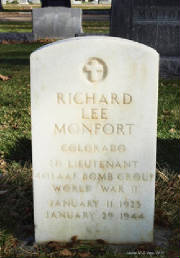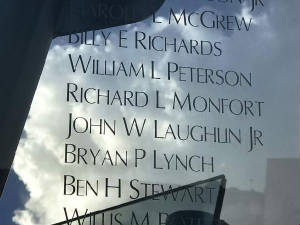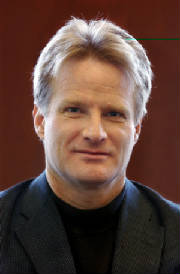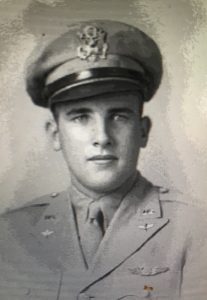
Greeley’s sprawling Linn Grove Cemetery was virtually deserted
Friday. Sprinklers seemed noisy. After a visit to the main office
to get a map and directions from Jackie at the reception desk,
I pulled up to
Block 14, Lot 50 and got out of the car.
There it was.
Among the graves of other Monfort family members, the white marble,
U.S. military-style headstone
announced:
RICHARD
LEE
MONFORT
COLORADO
2D LIEUTENANT
401AAF BOMB GROUP
WORLD
WAR II
JANUARY 11, 1923
JANUARY 29, 1944
A single bouquet
of flowers already was at the foot of the headstone.
»
» »
Richard Lee “Dick” Monfort was the son
of Greeley cattle feedlot
innovator Warren
Monfort and Edith Monfort. Dick’s sister,
Margery, was two years older. His
brother, Kenneth (“Kenny”),
was nearly six years younger.
After graduating from Greeley High in 1939, Dick was a junior at
Colorado State College of Agriculture and Mechanic Arts, or what
now is Colorado
State University, when he entered the Army Air
Forces in 1942.
While in training, he married Viola Swanson of Greeley.
In late 1943, Monfort
was deployed to Deenethorpe, England, with
the 8th Air Force’s 401st Bomb Group,
615th Squadron, joining the
fight against Germany. He was the navigator on Capt.
Lee Van Syckle’s
B-17 “Flying Fortress” bomber crew.
A massive 800-bomber daylight raid over Frankfurt was the 10-man
crew’s
third mission. It also was the first U.S. bombing foray to the
central German city following many
earlier British raids.
The date was JANUARY 29, 1944.
Denver radio personality Rick Crandall tirelessly champions
veterans causes.
His efforts led to the opening of the Colorado Freedom
Memorial in May 2013 in Aurora.
Before its dedication, Crandall
alerted me Richard L. Monfort’s name was on the
memorial, among
those of nearly 6,000 Coloradans killed or missing in action while
serving their country.
Crandall also obtained and forwarded to
me the “Missing Air Crew
Report,” opened after the mission and supplemented
over the next
18 months. It was declassified in 1973, and as is the case with
most
reports of that era based on interviews with survivors, it is remarkable
in its narrative detail, especially given the staggering number of
similar
reports that had to be done.
That day, Monfort
was in the nose of the B-17 with
bombardier Stanley Groski. Van Syckle’s plane dropped
its bombs and turned
away. Soon, a group of German
pilots in Messerschmitt fighters attacked the B-17 and
others in the lower
box of the American wing. The
Germans’ planes were equipped with machine guns and
cannons firing
20mm rockets.
Rockets struck Van Syckle’s Flying Fortress in
the wing
tanks, which caught fire, and the tail. Tail gunner Charles
Duke
yelled, “I’m hit!” And then, “I’m done for!”
In the nose, Groski, having completed his role as bombardier,
was firing the
chin turret gun when the plane was hit. The
impact knocked him back into Monfort.
The bailout order came amid the chaos. Groski later said he believed
Monfort was
hit before they jumped. Also, as Groski and Monfort left
the front of the plane, the German
pilots in the Messerschmitts still
were firing on the B-17.
After other crew members
jumped from their areas of
the bomber, ball turret gunner
Donald Lamb was horrified
to see radio operator Joseph
Glonek speed past him on
the way down. The lines of
Glonek’s chute were deployed, but the canopy was unopened.
Duke, the tail
gunner who had cried out, likely still was in the
plane when it exploded during its free fall.
On the ground, seven of Van Syckle’s crew members — or all except
Monfort, Glonek and Duke — were captured alive. The Germans
took co-pilot
Mitchell Woods to a village and told him two dead
members of the B-17 crew had landed
there. He was shown their
escape kits and watches and a navigator’s map. Woods
concluded
the dead Americans were Monfort and Glonek. The Germans
refused
to let him see the bodies.
The co-pilot also was told the chute of one American, which he assumed
was Glonek, hadn’t opened enough to save him, even if he was alive
when he reached the ground; and the chute of the other American,
presumably Monfort,
was unopened.
The next day, Stars and Stripes, the U.S. military
newspaper, reported
15 bombers — or fewer than 2 percent of the 800 on the mission
—
were lost. The story noted: “Preliminary reports of the Frankfurt
raid gave no indication last night of the opposition encountered
or the damage done, but some returning crews said they were
‘puzzled’
by the lack of German resistance on the way in. Neither
fighter nor flak opposition was
heavy, they said, until the Forts had
made their bombing run and were headed for the coast
— a further
indication of the success of the recent concerted assault on Nazi
fighter factories and airfields.”
Regardless of how many lost planes
there were, Monfort was
in one of them. And he didn’t survive. Two weeks later,
he was
reported to be among those Missing in Action. Then his death
was
confirmed. Other crew members became prisoners of war.
Dick had just turned 21. Kenny was 15. Walt Barnhart
later
wrote in his 2008 book, “Kenny’s Shoes,” that Kenny was fine
with Dick being ticketed
to head the family business and was
hoping to become a journalist. In 1948, Kenny and his
Colorado A&M fraternity buddy, future Colorado Governor
Roy Romer, visited Dick’s grave in
the military cemetery at
Nancy, France, near the German border. The remains were
brought back to Greeley.
Kenny had four children, including sons Dick and Charlie,
plus
daughters Kay and Kyle. When he served two terms
in the Colorado Legislature in the
tumultuous 1960s, Kenny —
who had been so affected by his brother’s death
— was
known as an anti-war Democrat. In 1980, he switched
parties.
He died in February 2001.
Kenny’s son Dick needs no introduction in Greeley, and it goes beyond
Dick’s long-time linkage to the
Monfort family business, including after
its 1987 sale, until his retirement from
ConAgra in 1995. He’s involved
in other business pursuits and is active in charity
and civic ventures,
currently serving as chairman of UNC’s board of trustees.
Outside of Greeley, he and Charlie are best known as the primary
owners of the Colorado Rockies. Dick is the team’s managing
general partner,
chairman and chief executive officer. Charlie is
listed as an owner/general partner.
Dick was born in 1954. His birth name is Richard Lee Monfort.
On
Sunday, Dick said when he was “7 or 8,” Kenny sat down
with Dick and
Kyle, two years older, and told the kids about
their uncle. Dick came away honored
to have been named Richard
Lee Monfort, and that feeling lingers.
“He told us how (my uncle) died in the war and how my dad really
looked
to him,” Dick said Sunday. “And how my uncle was going
to be the one
who was going to run the business and my dad was
going to do something else. He said
that he and his sister (Margery)
had both agreed they’d call their first male child Richard.”
Margery’s son, or Dick’s cousin, was Richard “Ricky” Wilson.
He died of leukemia at age 19.
“On a day like (Memorial Day),
I feel for anybody that died
in any type of war that we’ve had,” Dick
said. “God bless
them for doing all they did so we could have our freedom.”
» » »

I also paid a return visit to the Colorado Freedom Memorial
last week. The glass panels on the sweeping memorial in Aurora
variously angle forward or backward.
There it was,
on Panel 15 near the center of the memorial. Second
column, sixth row of names, against
a backdrop of puffy clouds
visible through the glass.
“RICHARD L MONFORT”
One name among the many.
Here, he represents all those we salute on Memorial Day.



